Eastern Orthodoxy 1
Eastern Orthodoxy Today - Mike Ervin
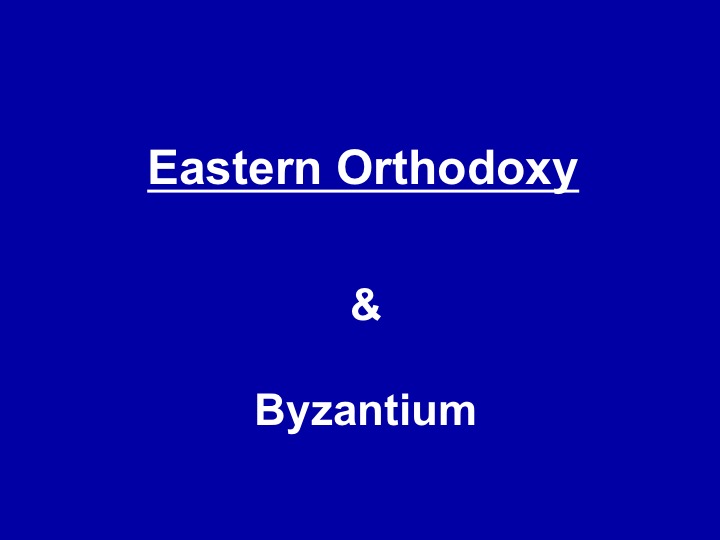
We enter today into a different world, the world of the Eastern Orthodox, one of the largest branches of the Christian tree, as you will see today as we review some Christian demographics, and probably the least understood version of Christianity in the western world.
Before we get into all of that I would like to first comment on why we are studying it today. Most of you participated in our last Open Forum in November of 2016. If you didn’t I will just mention that we have a meeting every November in which we review a large number of possibilities of classes we might want to hear in the next year or so. After we do that we have a vote (it is actually a confidential email vote) in which everyone ranks the possibilities that were discussed. And the winners in that vote are the classes that we schedule for the next year or so, assuming we can get a teacher to volunteer.
In that list of possibilities are always “big” classes, usually multiple weeks in size, and smaller topics, usually 1,2, or 3 weeks. There were questions in that meeting on whether we could do any more studies of other religions or others sacred texts. Someone raised their hand and said something like they would like to learn more about Orthodox churches like the one down the Bee Cave road. So we put it down on the list and it ended up getting a lot of votes.
Now I mentioned that it tends to be not well understood in the west, particularly in the US. A couple of reasons are usually given for that. One is that Eastern Orthodox Christians only make up 1.6% of the population in the US. Another is that few people get a good historical education about things that are more Eastern in origin because our history education tends to lean more toward Western Europe than Eastern Europe.
If you attended a university in this country and majored in world history, you may know all about the development of this branch of Christianity. But for many of us, who did not major in history, we got a truncated view of history with a strong western European bias. In that truncated view the Rise and Fall of the Roman Empire took place over about 500 years and ended in 476 A.D. when the emperor in Rome was overthrown by invading Germanic warlords. But in a more correct historical view the empire did not fall then, only the Western part. The capital of the Roman empire had already been moved to Byzantia and renamed Constantinople, grew and lasted for another 1000 years. This empire has come to be called Byzantium by modern historians, but at the time it was simply the Roman Empire.
Understanding Eastern Orthodoxy requires that we first understand Byzantium and its development and rather complex history. Since we are going to try to understand all of this in a truncated three-week study, we will have to give a “Readers Digest” version of that history, but it is important to understand
Before we dive into Byzantium though, I want to begin at the end and look at Eastern Orthodoxy today. Because it helps to know what it eventually became as we are looking at how it evolved to that.
So today I want to begin by taking a look at the demographics of the Christian religions of today in the world. So I am going to start by showing you some interesting religious demographics. I must begin with my normal disclaimer on religious demographics. Any data you see on religious demographics is wrong – including the data I will now show you. But it is probably fairly representative of the truth. The reason it is wrong though, is that every religion and every country that reports their religious demographics use different criteria and different methodologies for reporting.
My other disclaimer is that any time we examine another faith or denomination I that I will try, as much as humanly possible, to do it in a throughly agnostic manner. I will not attempt to point out what is good or bad about any aspect of their faith but to present my best understanding of their faith and practices. It is what it is.
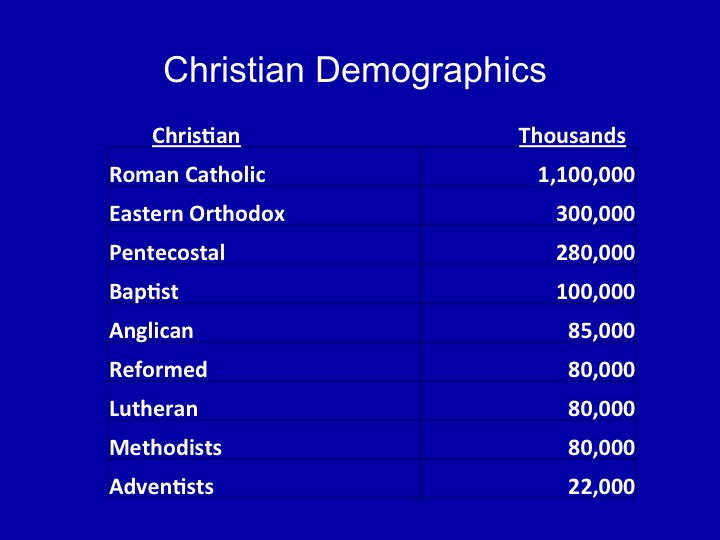
So we will begin with some religious demographics. Here is that suspect data I told you about. There are over 1.1 billion people who are reported as Roman Catholics. And the second largest denomination is the Eastern Orthodox that we will be learning about.
You may not be that familiar with the fact that proclaimed Pentecostals are almost as big and still growing in many parts of the world. Right after that are the Baptists, followed by fairly equal number of Reformed, Anglican, Lutheran, and Methodist. The actual list of Christian denominations is much, much longer than this. These are just the largest.
I should also mention that with any statistics like this you could of course change your categories or lumps and reach different conclusions. Let me give you some examples of that. You could easily look at this and say – “Well yes – but many of those on the list are various types of Protestants, so we if lumped them together they would outnumber the Eastern Orthodox. That is very true, in fact the Protestants would number about 800 million, easily outnumbering the Eastern Orthodox, but most of those Protestants are nowhere near in a common communion. You are probably aware that there are well over a thousand different versions of Christianity who do not agree with each other, and agree to disagree over sometimes rather small doctrinal differences. The Eastern Orthodox are remarkably one common communion – they all agree on doctrine and worship.
But even the Eastern Orthodox numbers are somewhat tainted. There is a splinter group from the Orthodox known as the Oriental Orthodox. Although they split over some doctrinal disputes they are included in these numbers because they practice their version of Orthodoxy in a manner very similar to the Eastern Orthodox. They represent about 50 million of the 300 million.
Another example that some have used is to identify a type of Christian called a Charismatic Christian. A substantial number of Christians, still growing rapidly in the global south and in Asia call themselves charismatics even though they are officially Catholics, or various forms of Protestants. A simplistic definition of charismatics is that they practice Pentecostal types of experiences like speaking in tongues, public healing, etc.; even though they are listed as Catholics or something else. Some have estimated that Charismatics number close to 300 million. So that a new category of Pentecostal + Charismatics would be very large.
But the main takeaway from this slide is that the Orthodox tradition is a major part of Christianity in the world today, just not in the US. I believe Austin has five Orthodox churches, including the fairly large one right down Bee Cave road on St. Stephens Road.
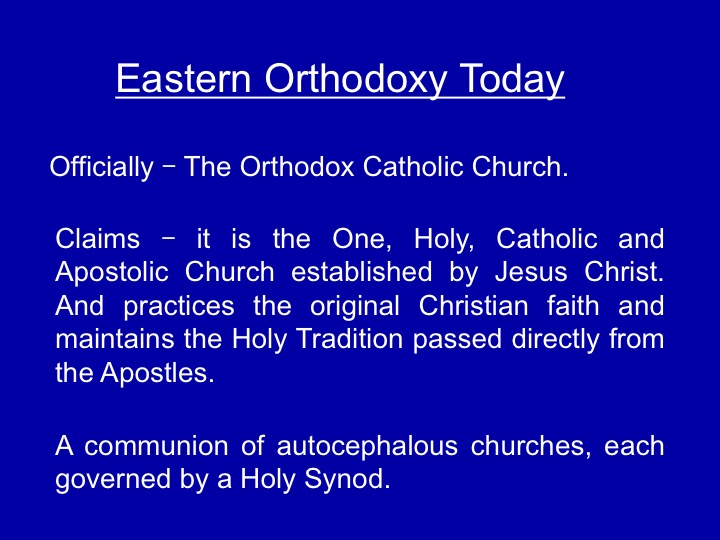
So let’s move on from comparison to others and start to focus on Eastern Orthodoxy today.
It is officially called Eastern Orthodox Church, also known as the Orthodox Church, or officially as the Orthodox Catholic Church, is the second largest Christian church and one of the oldest extant religious institutions in the world. The Eastern Orthodox Church teaches that it is the One, Holy, Catholic and Apostolic Church established by Jesus Christ in his Great Commission to the apostles. It practices what it understands to be the original Christian faith and maintains the sacred tradition passed down from the apostles. It is not well appreciated that during the first 8 centuries of Christian history, most of the important intellectual, cultural, and social developments in the Christian Church took place within the eastern Empire or in the sphere of its influence, where the Greek language was widely spoken and used for most theological writings. Important theological determinations, such as the Nicene Creeds, were made in the small city of Nicaea, near Constantinople.
The Eastern Orthodox Church is a communion of autocephalous churches, each typically governed by a Holy Synod. Your new word for the day is autocephalous. It sort of means self-headed. It means that all bishops in the church are equal by virtue of their ordination, and has no central governing structure analogous to the Papacy in the Roman Catholic Church
The most prominent episcopal
see is Constantinople. The majority of Eastern Orthodox Christians
live in Greece, eastern Europe,
the Caucasus and Russia, with less numerous communities in the
former Byzantine regions of the eastern
Mediterranean, Africa and the Middle East. There are also many
in other parts of the world, formed through immigration, conversion and
missionary activity.
The current Orthodox Church had shared communion with the Roman Catholic Church until the East–West Schism of AD 1054, which had been triggered by disputes over doctrine, especially the authority of the Pope. Prior to the Council of Chalcedon in AD 451, the Eastern Orthodox had also shared communion with the Oriental Orthodox churches, separating primarily over differences in Christology.
A
further clarification of terms is that the church we will be discussing is
exclusively called the Eastern Orthodox.
Many often refer to it as Greek Orthodox because all of its early
doctrine and organization was done in the Greek language. But the term Greek
Orthodox was never in official use and was dropped from as early as the 10th
century.
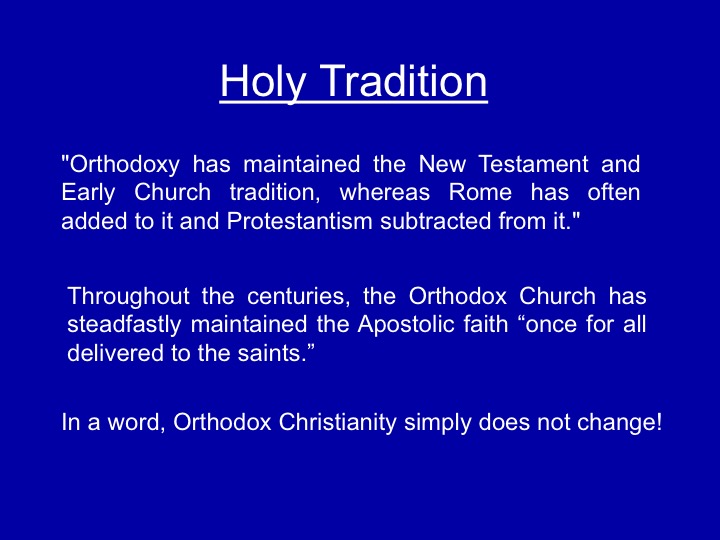
I would like today to make an opening observation about the term Holy Tradition.
We will be talking about this multiple times over the next few classes but to get you thinking about it, I copied some text from one of the Austin Eastern Othodox churches websites.
"Orthodoxy has maintained the New Testament and Early Church tradition, whereas Rome has often added to it and Protestantism subtracted from it."
"Throughout the centuries, the Orthodox Church has steadfastly maintained the Apostolic faith “once for all delivered to the saints.”
"In a word, Orthodox Christianity simply does not change!"
A bad word in Eastern Orthodoxy is “innovation”. Innovation is fine in business, but heresy in matters of faith.
What they are talking about here is a strong belief in Orthodoxy that Christianity had an oral tradition, like the oral Torah in Judaism. They often refer to the scripture in the book of John that says that Jesus taught the disciples many more things which if all written down would take many more books. The Orthodox church believes that those teachings, including how to worship, were memorized and later put down in writing.
That is all I will say about that now, but you will begin to better understand what Holy tradition can mean as we proceed through these classes.
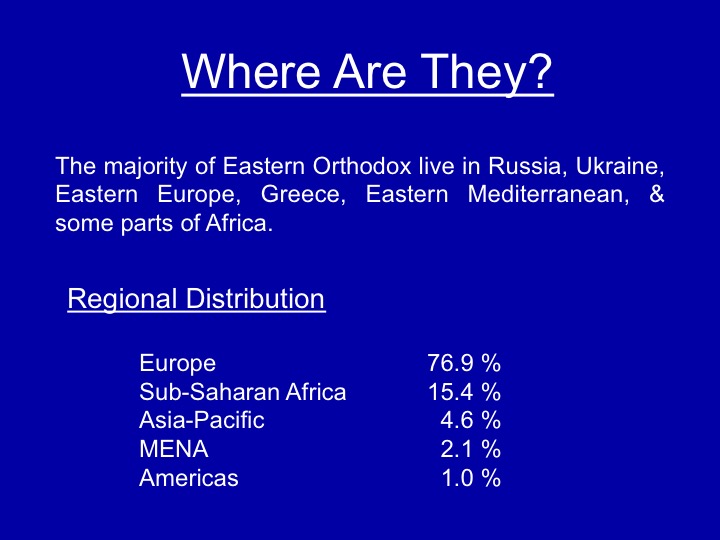
So where are they? Overwhelmingly, the Orthodox adherents are in Europe, and especially in Eastern Europe. By the way - Pew research routinely lists Russia as Eastern Europe. MENA is Middle East and North Africa. And note that all of the Americas, including North, Central, and South America, comprise only 1% of the Orthodox adherents in the world. Eastern Orthodoxy is very much a religion of the other side of the world from the Americas.
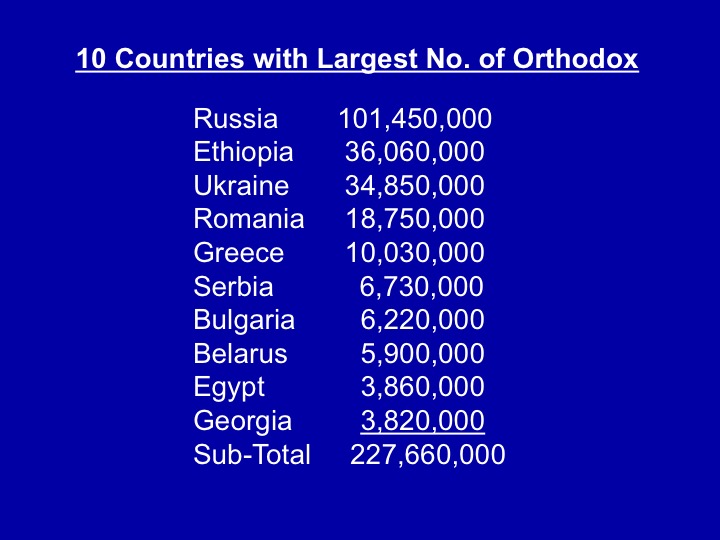
So where are most of the Eastern Orthodox? Russia is the dominant country. These 10 countries represent about 75% of all Orthodox adherents.
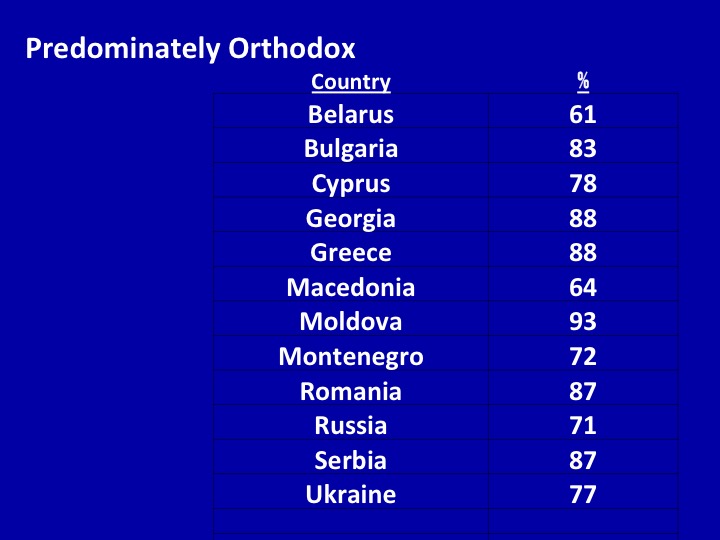
Finally, let's look at the demographics through one more lens. If we ask which countries of the world are predominately Orthodox, we get a remarkable large list. In all of these countries the percentage of the total population (not just the Christians) identify themselves a Orthodox.
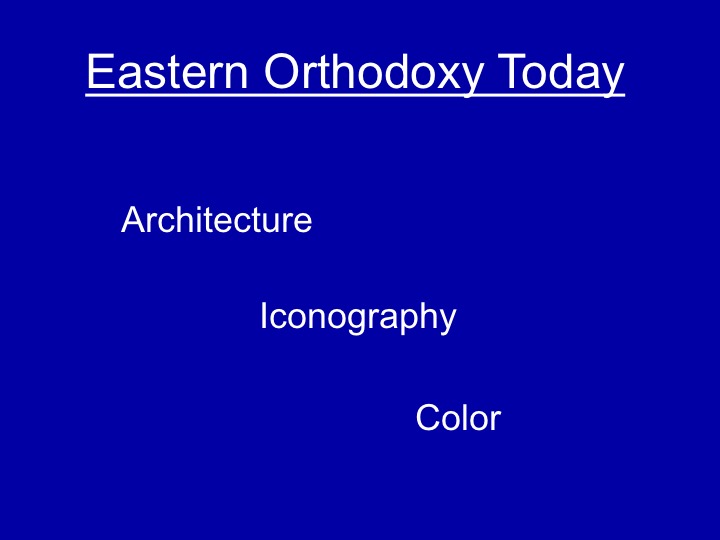
For the rest of today's lesson we will be looking at a lot of pictures. I would like to leave you today with some understanding of what some of the most distinctive aspects of this denomination are. And they are in the visual realm. We will show a number of images that reflect Architecture, the use of icons, and lots of color.
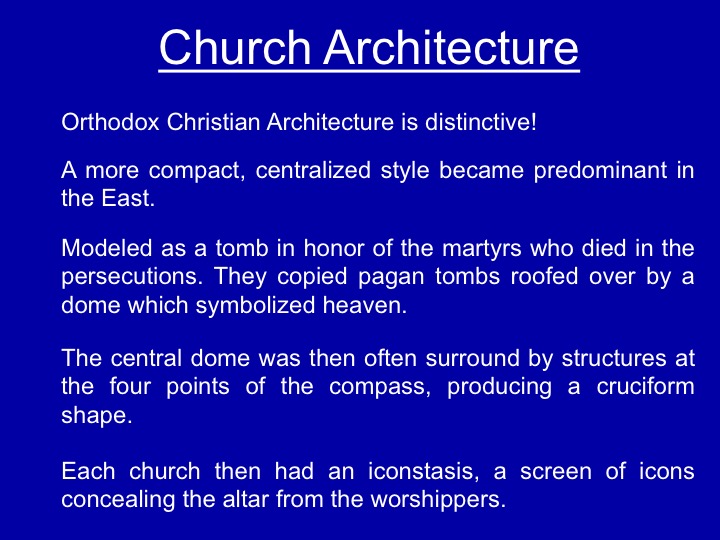
While sharing many traditions, Eastern Christianity and Western Christianity began to diverge from each other from an early date. Whereas the basilica, a long aisled hall with an apse at one end, was the most common form in the West, a more compact centralised style became predominant in the East.
These churches were in origin "martyria" focused on the tombs of the saints—specifically, the martyrs who had died during the persecutions, which only fully ended with the conversion of the Emperor Constantine. They copied pagan tombs and were roofed over by a dome which symbolized heaven. The central dome was then often surrounded by structures at the four points of the compass producing a cruciform shape - these were themselves often topped by towers or domes. The centralised and basilica structures were sometimes combined as in the church of Hagia Sophia in Constantinople. The basilican end then allowed for the erection of an iconostasis, a screen on which icons are hung and which conceals the altar from the worshippers except at those points in the liturgy when its doors are opened.
So, be thinking about architecture (and color) as we look at some typical Orthodox churches.
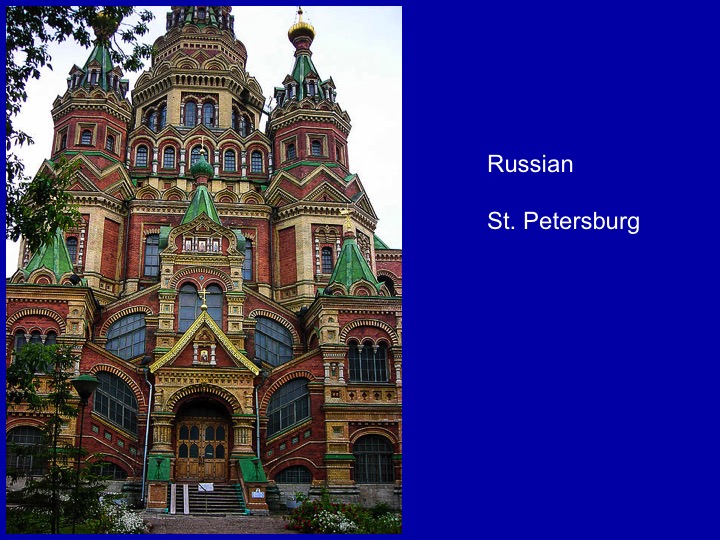
How is this for color! This is not that unusual. And note the compact form compared to the extended formats of Roman basilica churches of Western Christianity. These churches tend to draw the eye up rather than out. The liberal use of color extends into the church interiors also. We will look at some of those a little later. But this may not be colorful enough for you. In that case let's look at another one from Russia.
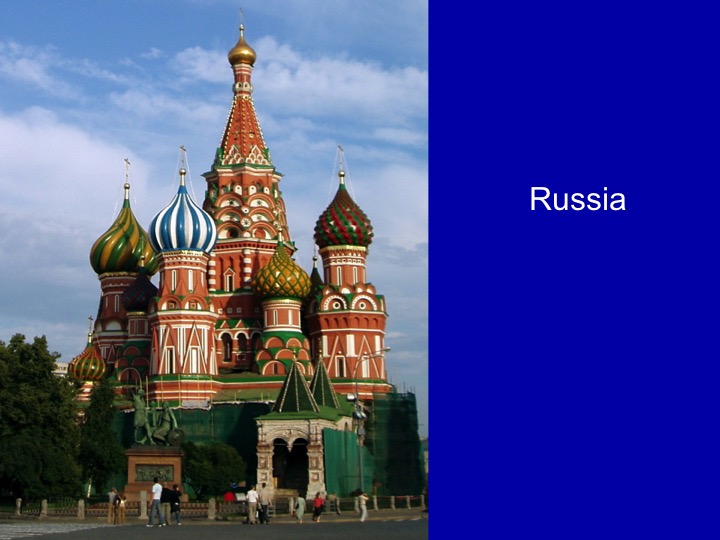
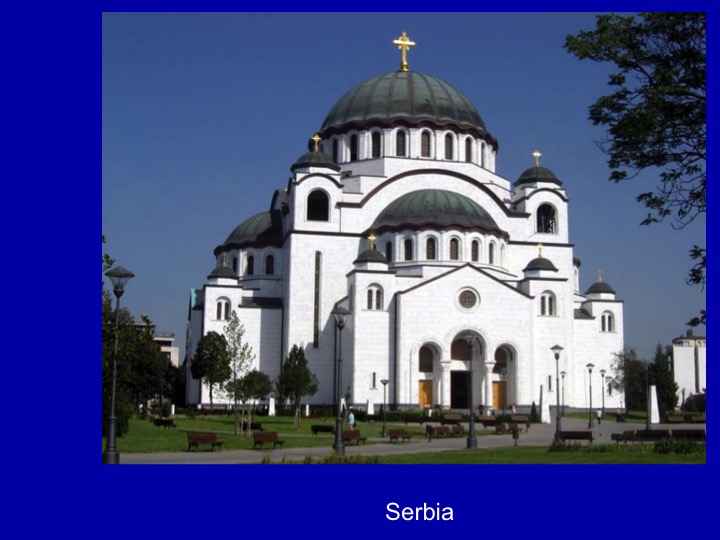
Some other countries are a little more subdued with color, but maintain the compact central design with a large domed top and the surrounding four features, each with a cross of its own.
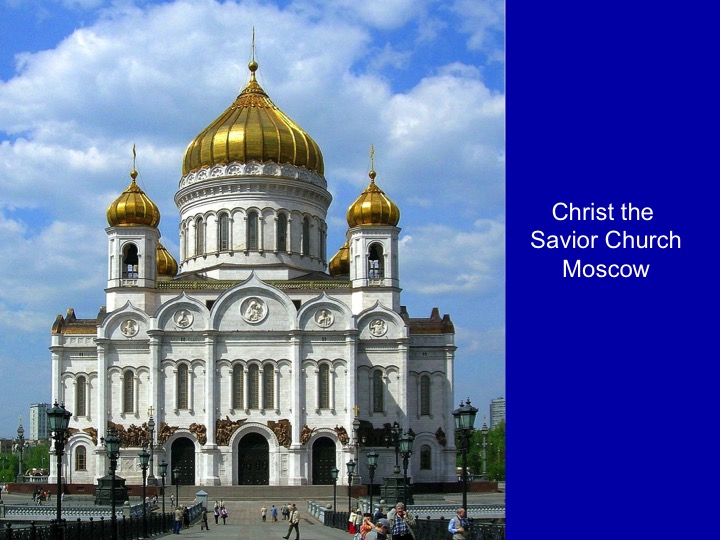
A very famous Orthodox church with a rich history is Christ the Savior Church in Moscow. Built as the largest church of its time in celebration of Russia's victory over Napoleon, it was later completely destroyed by the Bolsheviks during their purge of religion in Russia. Then later rebuilt. Note again the classic style of a compact form with a huge dome and surrounded by the four structures on the four points of the compass.
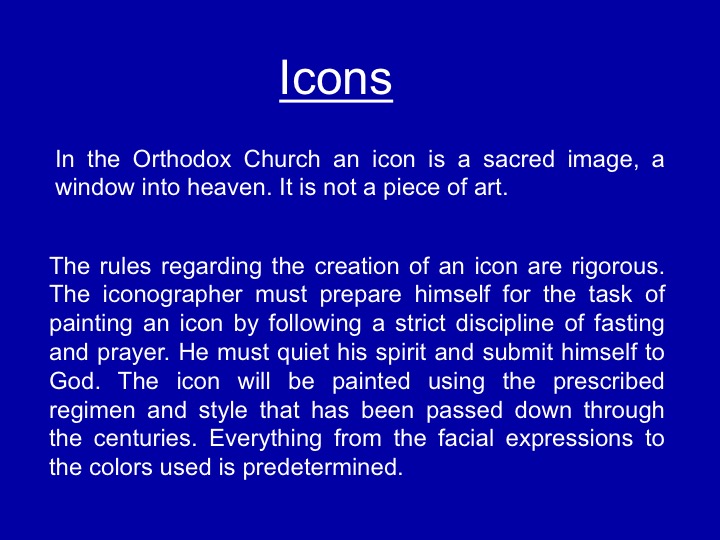
In the Orthodox Church an icon is a sacred image, a window into heaven. It is not a piece of art. An image of another reality, of a person, time and place that is more real than here and now. More than art, icons have an important spiritual role. One quote: “The Icon is a window on the Kingdom, theology in imagery, the icon expresses through color what the Gospel proclaims in words”.
For this reason the rules regarding the creation of an icon are rigorous. The iconographer must prepare himself for the task of painting an icon by following a strict discipline of fasting and prayer. He must quiet his spirit and submit himself to God. The icon he creates will not be signed. He will not expect accolades or applause when the icon is completed. The icon will be created to inspire and lead others into worship. Painting the icon is not a use of imagination. Instead, the icon will be painted using the prescribed regimen and style that has been passed down through the centuries. Everything from the facial expressions to the colors used is predetermined. The following is a prayer recited by an iconographer prior to starting to work:
"Divine Master of all that exists, enlighten and direct the soul, the heart and the mind of your servant: guide my hands so that I might portray worthily and perfectly Your Image, that of Your Holy Mother and of all the Saints, for the glory, the joy, and the beautification of Your Holy Church."
Icons have a controversial history in Orthodoxy. There was a period of Iconoclasm in Orthodoxy in which a newly appointed Emperor decided that Icons were graven images and should be eliminated. Many were. Eventually a new Emperor arrived who reversed that and icons are now well accepted.
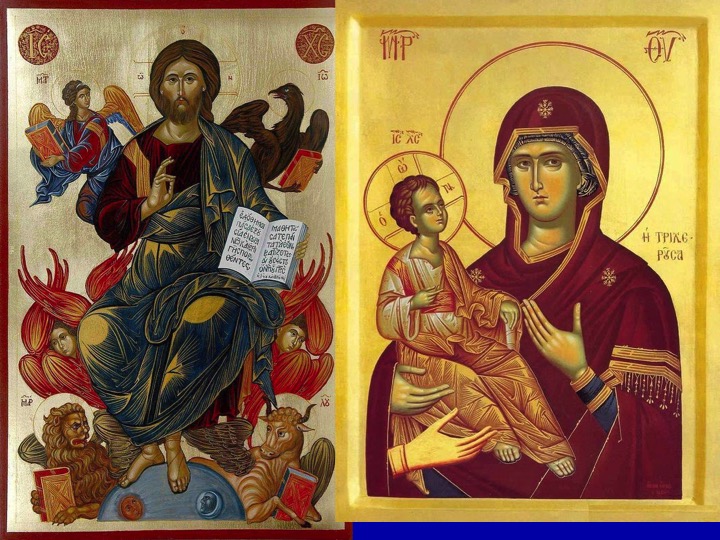
Icons depict silence. There are no actions displayed, no open mouths. The icon invites the Christian to enter into contemplation, prayer, and silence. Space is not defined as three-dimensional and time is insignificant. There are never shadows in icons. This shows us that the saint portrayed is “glorified” having completed the race and entered into heaven.
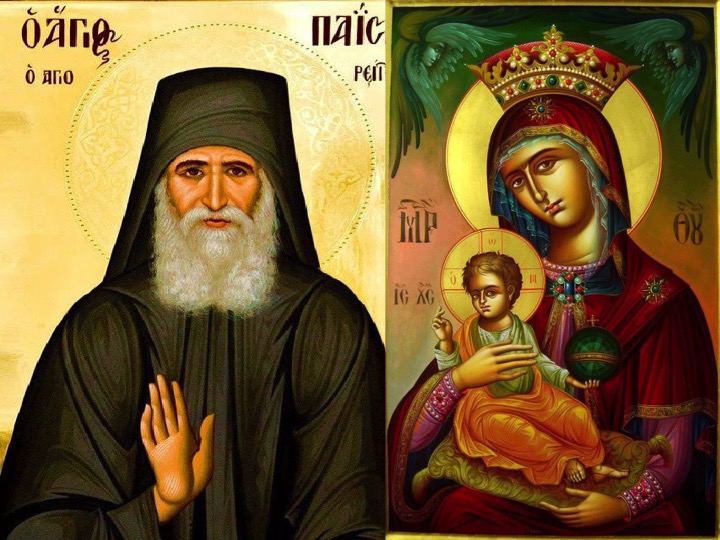
Symbolism
is used in icons and details are used minimally. For example, when showing John
the Baptist baptizing in the river the grown man he baptizes is shown as an
infant because the baptism is a rebirth. Colors are also symbolic. Blue reveals
heaven and mystery. Green is youth, fertility and the earth’s vegetation. Red,
the color of blood, suggests life, vitality and beauty. White is purity, the
divine world and innocence. Gold indicates sanctity, splendor, and the glory of
God and life in the heavenly kingdom. Purple reveals wealth, power and
authority.
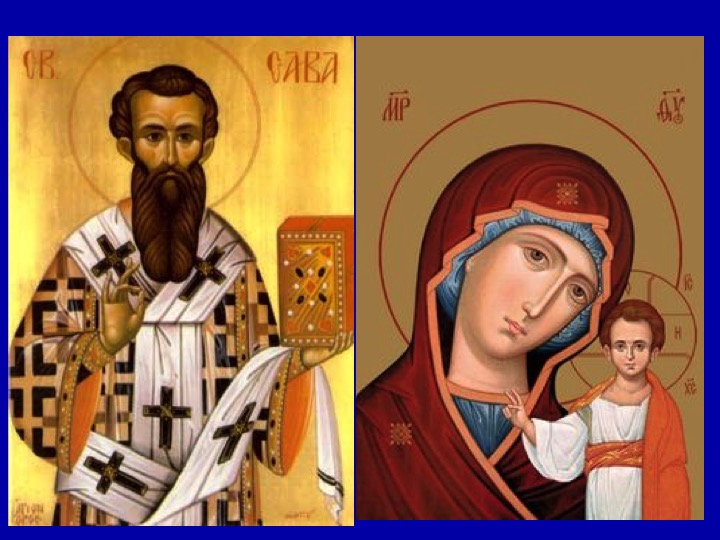
First
and foremost, icons are a constant reminder of the incarnation of Christ, that
is to say, they remind us that God “sent His only begotten Son”(Bible, John
3:16) to rescue us from our sin and death. We cannot see God the Father or God
the Holy Spirit, but, because Christ chose to take on human flesh, we can see
Him. His face can be portrayed on wood with paint. We can also paint His Mother
and other saints who have finished the race and gone on to heaven. The Orthodox
believe that surrounding themselves with icons help them to acknowledge the
constant presence of Christ and the saints in their lives.
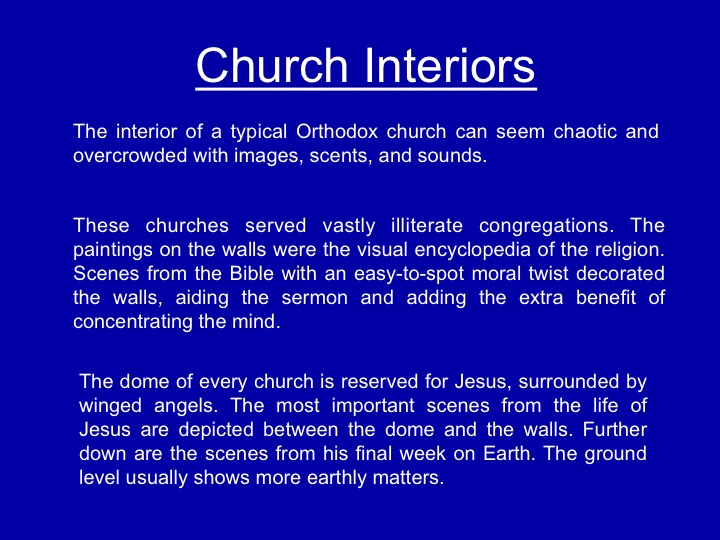
The interior of a typical Orthodox church can seem chaotic and overcrowded with images, scents, and sounds.
At first, it might be hard to realize that every detail here follows a set of strict rules.
These churches served vastly illiterate congregations. The paintings on the walls were the visual encyclopedia of the religion.
Scenes from the Bible with an easy-to-spot moral twist decorated the walls, thus aiding the sermon and adding the extra benefit of concentrating the mind.
The dome of every church is reserved for Jesus, surrounded by winged angels.
The most important scenes from the life of Jesus are depicted between the dome and the walls. Further down are the scenes from his final week on Earth. The ground level usually shows more earthly matters like historical figures, kings, and church donors.
Let's begin our look at interiors at the Christ the Savior Church, the large church we showed earlier in Moscow.
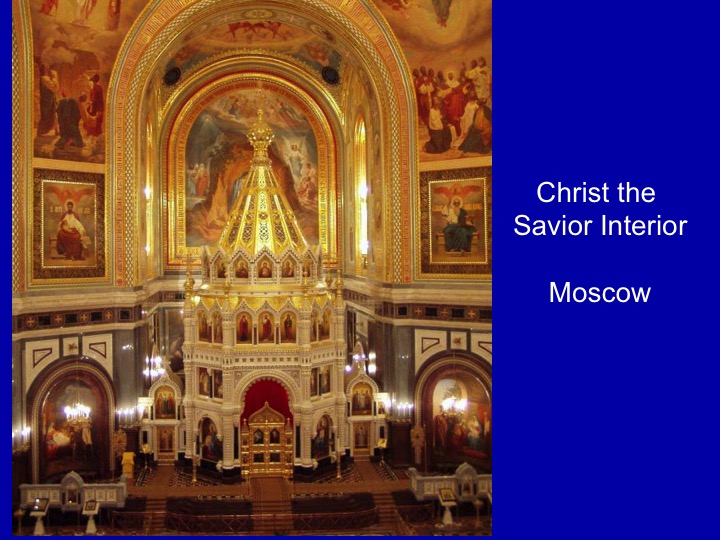
Note that the church is resplendent with Icons. The tall iconstasis facing the congregation has three doors. the prominent center doors are for the use of the priests only. There are two side entrances which are entry and exit points for the deacons and altar boys that participate in many of the rites that go on behind the Iconstasis.
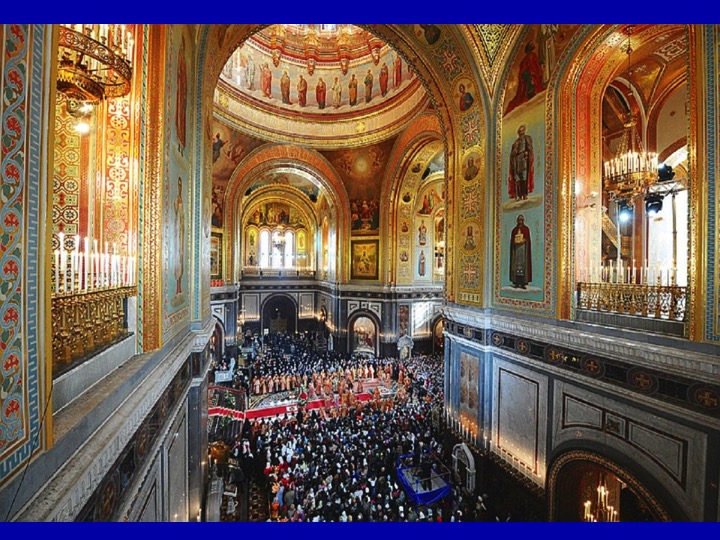
The size of the Christ the Savior Church is evident from this view from one of the side wings of the church during a service. 11,000 can attend a service. They usually stand for the entire service that may take 2.5 to 3 hours. Note that every part of the church is decorated with icons.
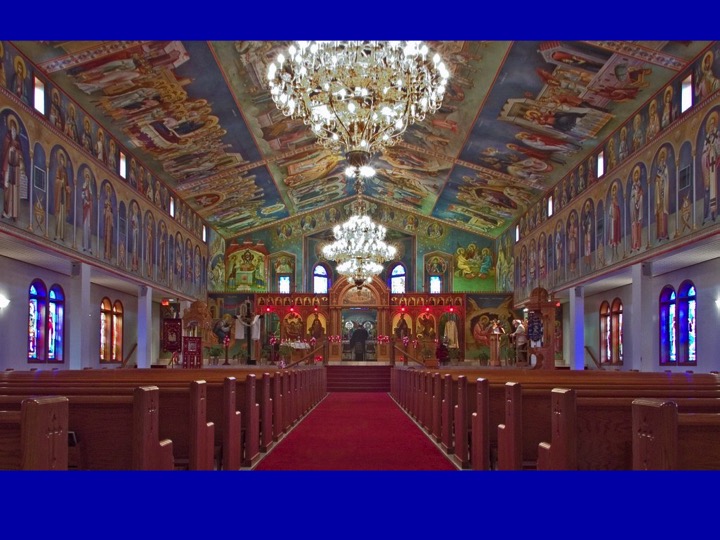
In smaller churches, such as this one in Missouri, an expensive central dome is replaced by a simpler design, which still allows maximum use of iconography.
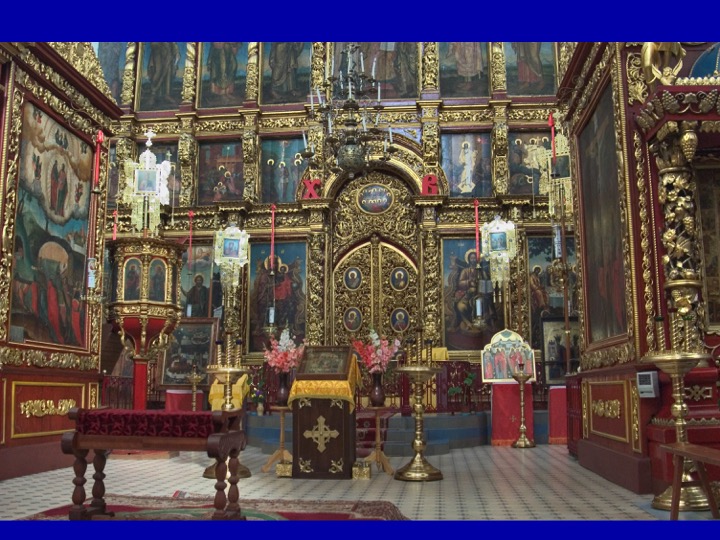
Another church interior with a close-up of the iconstasis, and all of the trappings of the service.
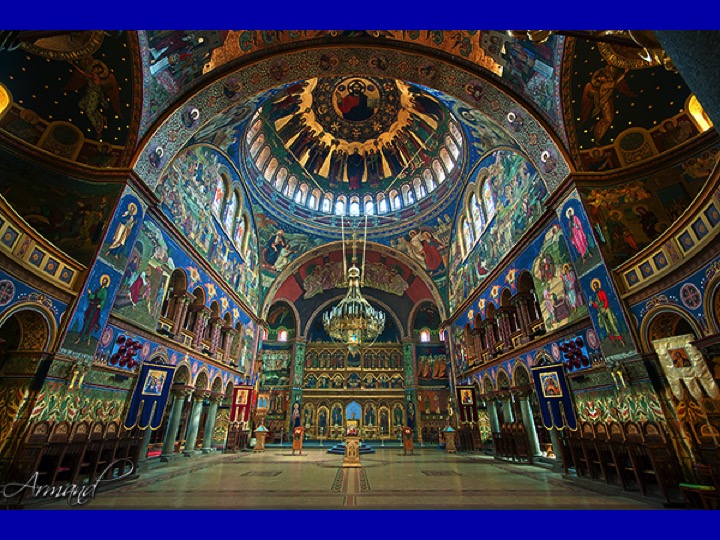
A large domed church with the iconstasis at the far end. Note the top of the central dome has an icon of Jesus. Note also there are no chairs.
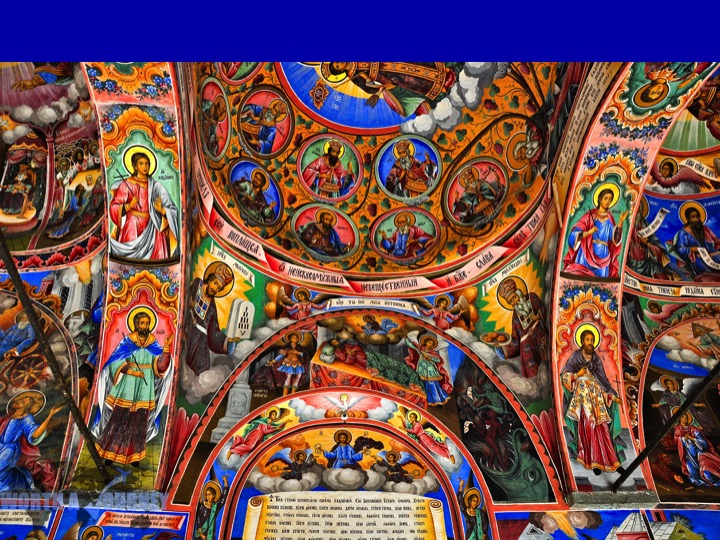
And finally a very beautiful use of icons in a Orthodox church that is part of a monastery. It may be that the monks painted this montage themselves.
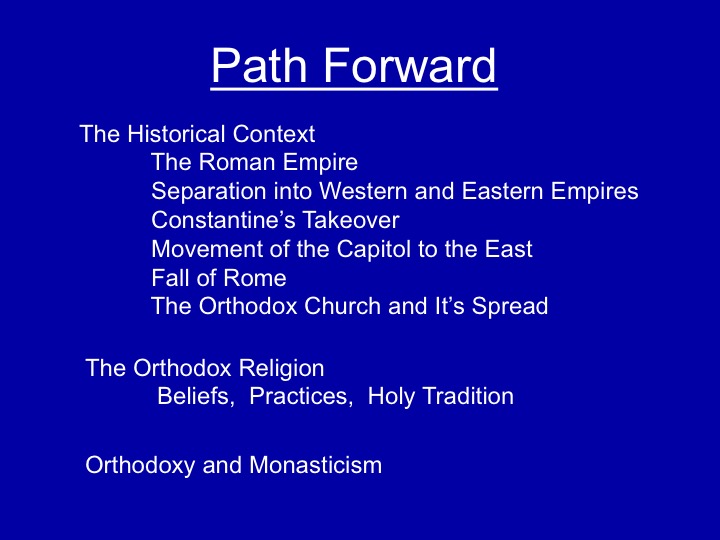
And what is next? We are going to first jump back from today's emphasis of current Orthodoxy and try to put some historical perspective on how this Christian tradition got to it's current state. To do that we must return to the early Roman empire and it's movement of the capitol in the fourth century from Rome to Constantinople. And then explore how the Christian church evolved from that.
Then we will spend some time examining the beliefs and rites supporting Holy Tradition before moving on to an examination of the importance of monasticism to Orthodoxy.
< Audio >